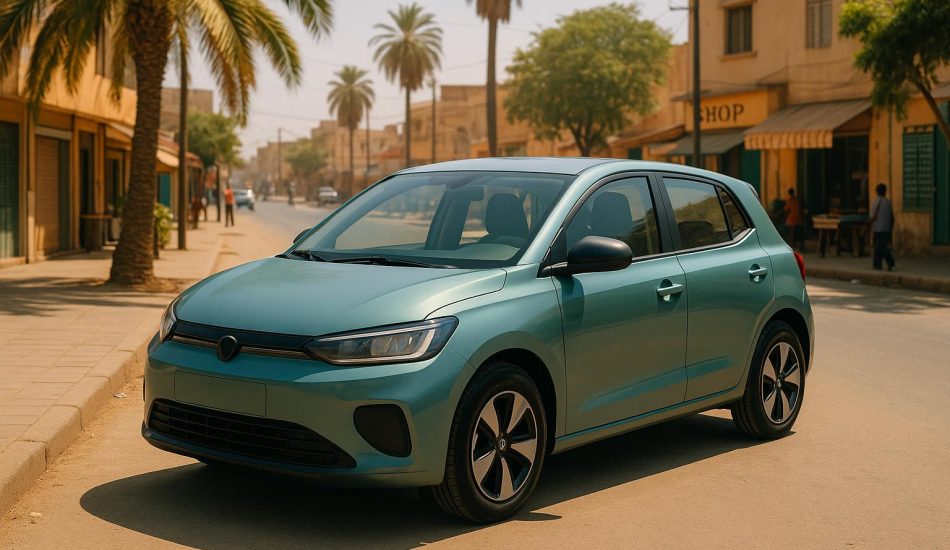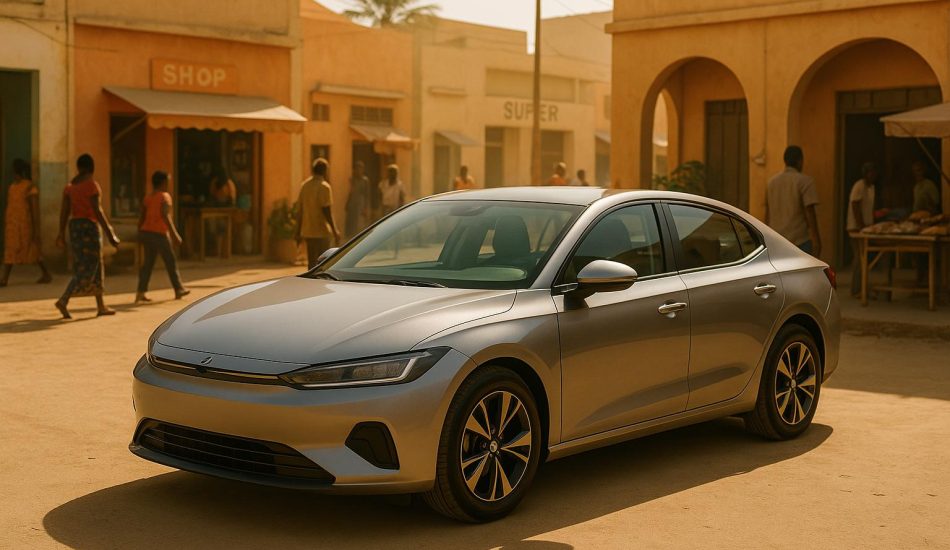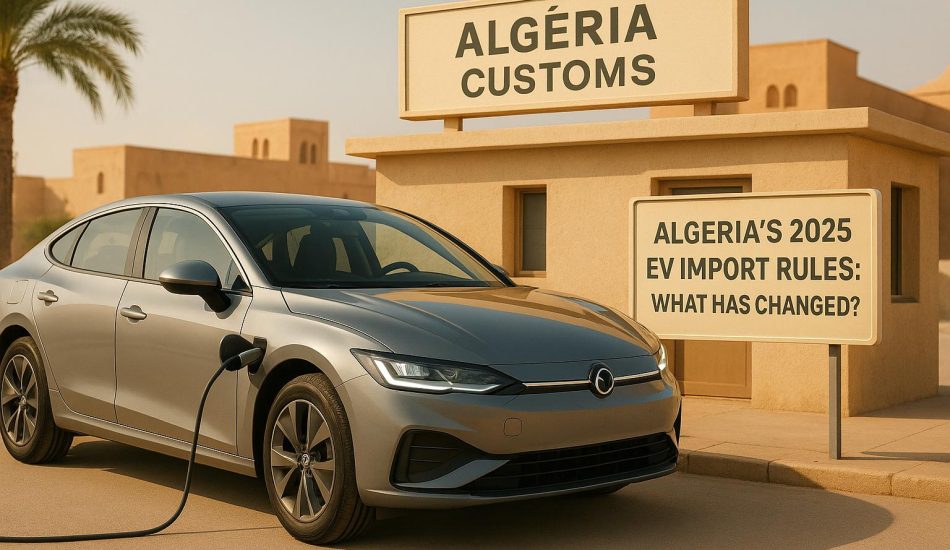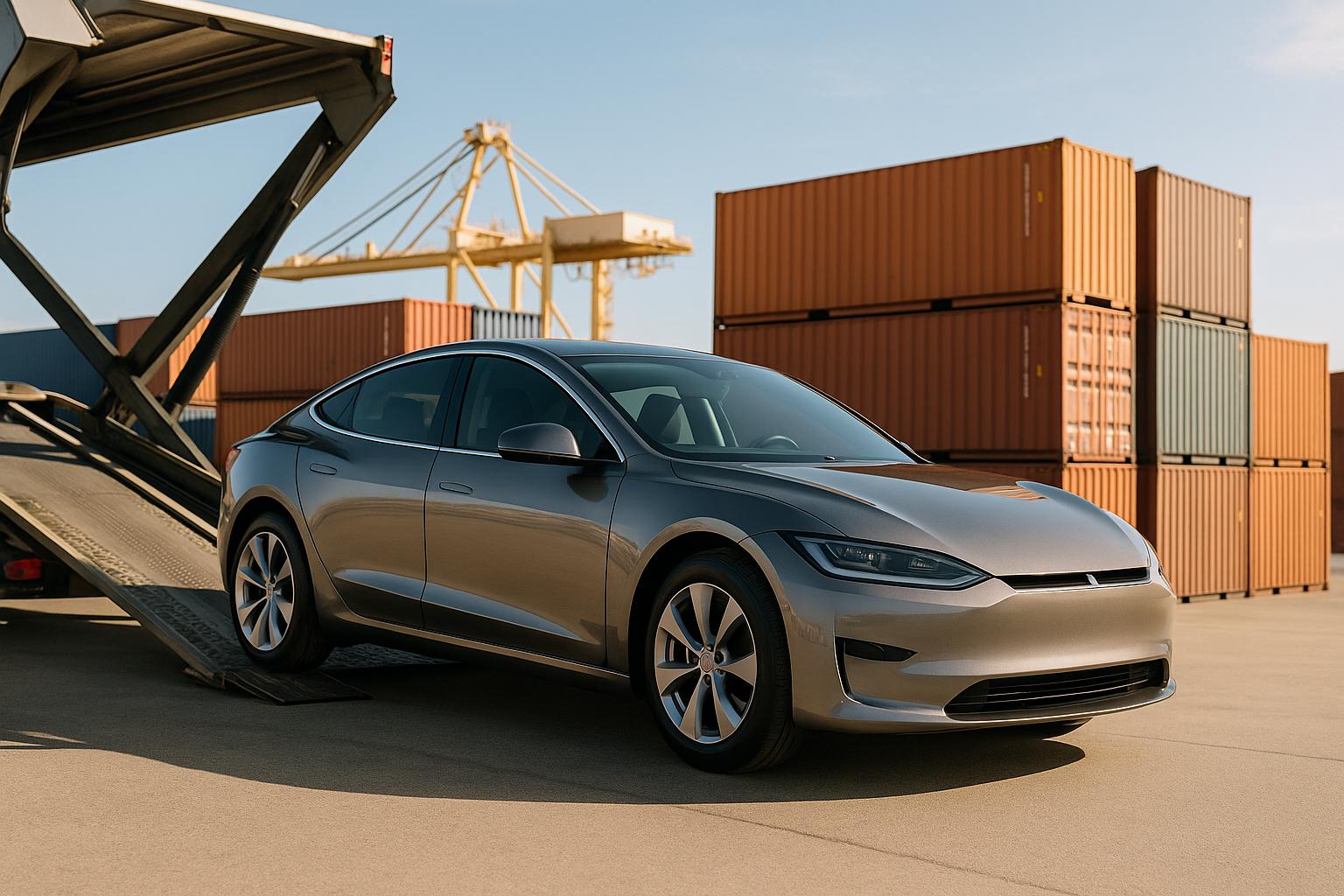
Importing an electric vehicle (EV) to South Africa in 2025 can be a complex process, but it’s manageable if you follow the right steps. Here’s a quick breakdown:
- Choose the Right EV: Make sure it’s a right-hand drive model that complies with South Africa’s regulations. Popular options include models from BYD, Geely, and GWM.
- Gather Documentation: Obtain an import permit (Form IE462), a Letter of Authority (LOA), safety certifications, and other required paperwork.
- Arrange Shipping: Decide between roll-on/roll-off (RoRo) or container shipping. Costs range from $1,500 to $4,500, depending on the method and origin.
- Clear Customs: Be prepared to pay a 25% import duty, 15% VAT, and potential luxury taxes (up to 30%). Ensure all customs documents are accurate to avoid delays.
- Register the Vehicle: Complete roadworthiness tests, secure an LOA, and register the EV with your local licensing office.
- Calculate Costs: Factor in duties, taxes, shipping, and registration fees. Budget for additional expenses like insurance and demurrage fees.
- Plan for Maintenance: Research local service providers for ongoing support and spare parts availability.
While high import duties and taxes increase upfront costs, the long-term savings on fuel and maintenance can make EV ownership worthwhile. Partnering with experienced agents or platforms like EV24.africa can simplify the process and ensure compliance with regulations.
Ship Car to South Africa | Everything You Need to Know About Importing a Car to RSA
Step 1: Choose the Right Electric Vehicle
Picking the right electric vehicle (EV) is a crucial first step, especially in South Africa, where the range of available models is limited. Your choice needs to align with both local regulatory requirements and practical considerations. With high import costs and strict rules, this decision can have a significant impact on your overall investment.
Importing an EV into South Africa is not cheap. Joubert Roux, Founder of CHARGE, highlights the challenge:
"South Africa’s current EV import duties, which make EVs far more expensive than ICE vehicles, are actively stalling market growth".
The numbers back this up. Import duties stand at 25%, and additional ad valorem taxes can climb as high as 30% for luxury vehicles priced over $333,000. This means your vehicle selection directly affects how much you’ll spend, making it essential to weigh your options carefully.
Right-Hand Drive Requirements
South Africa enforces a strict ban on left-hand drive vehicles, except for those registered before January 1, 2000, with proper proof of ownership. If your vehicle doesn’t meet these specific exceptions, the National Regulator for Compulsory Specifications (NRCS) will deny the required Letter of Authority (LOA), effectively blocking the import process.
This regulation limits your choices, as many popular EV models are designed for left-hand drive markets. Before committing to a purchase, make sure the model you’re considering is available in a right-hand drive version and is suitable for South African roads.
Interestingly, Chinese EV brands are stepping up to meet this demand. Companies like BYD, Geely, Chery, GWM, and Chang’an now dominate 60% of the local market, offering compliant right-hand drive options.
Once you’ve confirmed that your EV meets local steering and design requirements, the next step is ensuring it complies with safety standards.
South African Bureau of Standards Certification
Every EV imported into South Africa must pass South African Bureau of Standards (SABS) certification. This process costs approximately ¥15,000 (around $2,100) and remains valid for two years. Certification applies to motor vehicles in categories M, N, O, and L, ensuring they meet safety and environmental standards.
For EVs, battery safety documentation is especially important. You’ll need to provide a Material Safety Data Sheet (MSDS) for review by both the carrier and customs officials.
To streamline this process, consider working with certified service providers like ATIC, which handle NRCS and SABS testing and audits. These services can help you avoid unnecessary delays.
Keep in mind that South Africa has an age limit of 20 years for imported vehicles, so your EV must fall within this range. If you’re importing from China, it’s wise to work with a reliable exporter who can supply all required documents, such as commercial invoices, Certificates of Origin (COO), export customs declarations, and technical files.
For luxury EVs priced over $333,000, you might want to explore alternative import routes. For example, importing through Botswana under the Southern African Customs Union (SACU) agreements could reduce your duty rate to 10%, significantly lower than South Africa’s higher taxes on luxury vehicles.
Once you’ve selected an EV that meets all these requirements, the next step is gathering the necessary paperwork to proceed with the import process.
Step 2: Get Required Documentation
Having the right paperwork is crucial to ensure a smooth EV import process. In South Africa, importing a vehicle involves obtaining several documents from various agencies, and even a minor oversight can lead to costly delays. While most of these documents are free, processing times can vary, so planning ahead is key.
The International Trade Administration Commission (ITAC) is responsible for issuing import permits. These permits are free of charge and typically take about five working days to process once all necessary documents are submitted. Failing to secure the required paperwork on time could result in customs penalties.
Import Permit Application
To import an EV, you’ll need to complete Form IE462, which is the application for importing second-hand or used passenger vehicles. Keep in mind that this permit is non-transferable and only valid for the calendar year in which it is issued.
ITAC only issues these permits to South African citizens, permanent residents, or returning nationals. Applications from other individuals will be rejected.
For South African citizens or returning residents, the following documents must accompany Form IE462:
- A valid identity document or passport to confirm citizenship.
- A letter from your employer verifying your permanent employment abroad, including the duration of employment. Note: Salary slips, contracts, job offers, or work permits are not accepted as substitutes.
- A certified copy of the official foreign vehicle registration certificate.
For immigrants with permanent residence status, you’ll need to include:
- A copy of your South African permanent residence certificate.
- A copy of your foreign passport (showing the photo and details page).
- A copy of the foreign motor vehicle registration certificate (or vehicle license document V5).
- If applicable, proof of study or research.
If you choose to use a South African agent to forward your permit, expect a courier charge of around $30 (approximately ZAR 450).
Required Paperwork
Beyond the import permit, several additional documents are needed for customs clearance. The South African Revenue Service (SARS) requires a Single Administrative Document (SAD) as the main customs declaration form.
Your shipping documents should include the following:
- One negotiable and two non-negotiable copies of the Bill of Lading for sea freight.
- A Commercial Invoice with four copies and one original. Be sure to include the correct purchase value, as zero-value invoices are not accepted.
- Three copies of the Packing List.
For EVs, there are additional requirements:
- Battery Electrical Safety Data Sheets (MSDS) are mandatory to provide shipping carriers and customs officials with details about the vehicle’s battery safety specifications.
- The Electronic Cargo Tracking Document (ECTN/CTN/ACID) must be submitted at least five days before your EV arrives at any African port. Missing this deadline can lead to significant fines or delays.
- Manifest data, including details such as the VIN number and battery capacity, must be provided 72 hours in advance.
If you’re eligible for duty exemptions or reduced rates, include the Declaration of Origin Form (DA59). For returning residents or immigrants relocating permanently, who qualify for duty and VAT exemptions, the Form DA304A is also required.
To avoid unexpected storage fees at the port, set aside 3% of your cargo’s value as a demurrage reserve. This buffer can help cover potential delays in customs clearance.
If this is your first time importing a vehicle, consider hiring a reputable freight forwarding agent familiar with South African import regulations. Their expertise can ensure that all your documentation is correctly prepared and submitted on time.
Once all the required paperwork is in order, you can move forward with arranging the shipping and delivery of your EV.
Step 3: Arrange Shipping and Delivery
Once your paperwork is sorted, it’s time to decide how you’ll ship your EV. This decision is crucial since it affects both the cost and delivery timeline. Let’s break down the options.
Choose a Shipping Method
When importing EVs to South Africa, you have two main shipping methods to consider: Roll-on/Roll-off (RoRo) and Container Shipping. Each comes with its own set of benefits.
RoRo Shipping
RoRo is the more budget-friendly option, costing about $2,200 per vehicle. With this method, your EV is driven directly onto the ship and secured on the deck. It’s a faster option with frequent departures, making it ideal for operational vehicles. However, keep in mind that RoRo doesn’t shield your car from weather conditions during transit.
Container Shipping
Container shipping provides full enclosure for your EV, offering better protection. Costs range from $2,150 to $2,250 for standard vehicles, and a 40-foot container can even accommodate multiple shipments or spare parts. Unlike RoRo, this method accepts non-operational vehicles, making it a better choice for EVs that can’t be driven.
For used EVs equipped with lithium-ion batteries, Hazmat containers are required. Since RoRo vessels lack the controlled conditions needed for hazardous materials, container shipping becomes the go-to solution for these cases.
Before shipping, make sure your EV’s battery is charged to 30%–50% for stability during transit. Additionally, you’ll need to prepare a Dangerous Goods Declaration and a Container Packing Certificate, as EVs are classified as dangerous goods under international shipping regulations.
Air Freight
If time is of the essence, air freight is an option. While it’s the quickest method – taking only 3 to 10 days – it comes with a hefty price tag of over $10,000, making it impractical for most imports.
Once you’ve chosen your shipping method, it’s time to map out your route and timeline.
Shipping Routes and Timelines
Now that you’ve picked a shipping method, plan your route and schedule to align with your delivery needs. The most common and economical route for EV imports to South Africa starts at major Chinese ports – Shanghai, Ningbo, and Guangzhou – and ends at Durban Port. Transit from China typically takes 30–40 days.
For shipments originating in the United States, expect transit times of 30–45 days from East Coast ports and 45–60 days from West Coast ports. These estimates include the time needed for loading, sailing, and initial port processing.
Shipping costs from Chinese ports to Durban usually range between $1,500 and $2,500 per vehicle, making this route a cost-effective choice. Don’t forget to factor in additional expenses like:
- Shipping insurance: 1–3% of your vehicle’s value
- Port charges: $200–$500
- Destination charges: Around $400
- Broker fees: $395 or 3% of your vehicle’s price
When finalizing your shipping route, ensure your transporter has experience handling EVs. This includes maintaining climate-controlled cargo holds with temperatures between 68°F and 86°F (20°C to 30°C) and humidity levels below 60%, which are essential for protecting lithium-ion batteries. Lastly, double-check that your insurance provides full coverage for your EV.
Step 4: Clear South African Customs
Once your EV arrives at Durban Port, the customs clearance process begins. This step is where most of your import costs will come into play, so knowing the fee structure and having the right paperwork ready is crucial to avoid unnecessary delays or expenses.
Duties, VAT, and Levies
Customs fees in South Africa can heavily influence the total cost of importing an EV. For electric vehicles coming from most regions, including China and the United States, there’s a 25% import duty. This rate is notably higher than the 18% duty applied to petrol and diesel vehicles imported from Europe and the UK, which benefit from favorable trade agreements.
These elevated duties make EVs pricier than traditional internal combustion engine (ICE) vehicles, which has slowed the growth of the EV market in South Africa.
In addition to the import duty, you’ll need to account for the 15% Value Added Tax (VAT). The VAT is calculated using the Added Tax Value (ATV), which follows this formula: [(Customs Value + 10% thereof) + (any non-rebated duties levied on the goods)] x 15%. The 10% markup on customs value applies to imports from countries outside the Customs Union (Botswana, Lesotho, Namibia, and Swaziland).
Another potential cost is the ad valorem tax, or luxury tax, which can reach up to 30% depending on the declared value of your vehicle. High-end EVs are more likely to incur this additional levy.
If your EV includes lithium-ion batteries shipped as separate components, expect a 10% duty on those batteries under Chapter 98 regulations. Additionally, anti-dumping and countervailing duties may apply if customs determines that your vehicle was "dumped" or subsidized, based on pricing and export incentives from the country of origin.
| Import Source | Petrol/Diesel Duty | Electric Vehicle Duty |
|---|---|---|
| Europe and the UK | 18% | 25% |
| SADC region | Reduced or duty-free | Reduced or duty-free |
| Rest of the world | 25% | 25% |
With these fees in mind, ensuring all required documents are ready is the next step.
Customs Documentation
To clear customs efficiently, prepare a comprehensive package that includes the following:
- Bill of Lading
- Commercial Invoice
- Packing List
- Certificate of Origin
- Certificate of Conformity (COC)
- Roadworthiness Certificate
For EVs, additional documentation is required, such as battery safety papers like the UN38.3 report and Material Safety Data Sheet (MSDS).
You’ll also need to submit an electronic cargo tracking document (ECTN/CTN/ACID) at least five days before your vehicle reaches any African port. Missing this deadline could lead to fines or delays.
When it comes to customs clearance, you’ll need to provide manifest data with 17 key details, including the vehicle’s VIN number and battery capacity. If you’re importing from China, include a certificate of origin under the China-Africa Free Trade Agreement to potentially qualify for a 5% VAT exemption.
Additionally, South African Bureau of Standards (SABS) certification is mandatory and costs around $2,000, valid for two years. It’s also wise to set aside about 3% of your cargo value as a reserve for potential demurrage fees due to customs delays.
After submitting your documents, be prepared for inspections and emissions tests at the port. Hiring a local customs agent can be a smart move – they can help manage customs duties, VAT payments, road registration, and the certificate of conformity inspection.
Being well-prepared with all the necessary paperwork and understanding the process can significantly reduce delays and ensure a smoother experience. Missing documents or failing inspections, however, can extend the timeline and increase costs.
sbb-itb-99e19e3
Step 5: Register the Vehicle in South Africa
Once your EV has cleared customs, the next step is to register it with the South African Department of Transport. This involves obtaining key certifications and completing the formalities at your local licensing office.
NRCS Approval and Roadworthy Test

Before you can officially register your imported EV, you’ll need to secure a Letter of Authority (LOA) from the National Regulator for Compulsory Specifications (NRCS). To do this, submit Form LA01, along with your vehicle’s technical specifications and supporting documents. The LOA confirms that your EV complies with South African safety, emissions, and technical standards.
The fees for this application typically range between R300 and R1,800, depending on the type of vehicle, such as passenger cars or motorcycles. If your EV doesn’t meet local standards, modifications may be required.
Next, your vehicle must pass a roadworthy test at an approved testing station. This test ensures your EV meets South African mechanical and safety requirements. The cost for the test is around R650, and once passed, you’ll receive a Roadworthy Certificate.
Additionally, you’ll need to obtain a South African Police Service (SAPS) clearance certificate. This certificate is typically issued during the registration process after being referred by the registering authority.
Once these steps are completed, you’re ready to proceed with the final registration of your EV.
Vehicle Registration Process
To register your EV, visit your local licensing department with the following documents:
- A completed eNaTIS form (MVR1A or RLV)
- A South African ID or a foreign ID with a traffic register number certificate
- Proof of residence, such as a utility bill or lease agreement
- The original registration documents from the vehicle’s country of origin
- Proof of purchase, such as a sales invoice
- The LOA from NRCS
- Customs Release Notification or a stamped Bill of Entry, confirming customs clearance and payment of duties and taxes
- Your Roadworthy Certificate and SAPS clearance certificate
If you’re registering the vehicle under a company name, you’ll also need a certificate of incorporation or a founding statement issued under South Africa’s business regulations.
The registration process is relatively affordable. Here’s a breakdown of the costs:
| Component | Price |
|---|---|
| Registration Fee | R1,000 |
| Roadworthy Certification | R650 |
| Permits and Licensing (LOA) | R450 |
| NRCS Application Fee | R300 – R1,800 |
Once your registration is processed and approved, your EV will be issued South African license plates, making it fully legal to drive on public roads. If all your documents are in order, the process usually takes just a few days.
Step 6: Calculate Import Costs
Once your registration is complete, the next critical step is to accurately estimate the costs involved in importing your vehicle. It’s not just about the purchase price – you’ll need to budget for duties, taxes, and shipping fees that can add up quickly. Breaking these costs into specific categories like import duties, taxes, and shipping expenses will help you create a more precise financial plan.
Import Duties and Taxes
Importing a vehicle into South Africa involves several layers of taxation. Customs and ad valorem duties are calculated based on the value of your electric vehicle (EV). Simply put, the more expensive the vehicle, the higher the duties you’ll pay. The formula for Value-Added Tax (VAT) is:
VAT = (Customs Value + 10% markup + non-rebated duties) x 15%.
The 10% markup applies to vehicles imported from countries outside the Customs Union, which includes Botswana, Lesotho, Namibia, and Swaziland. Since VAT is applied on top of other taxes like import duties and ad valorem taxes, the overall tax burden can be substantial. Additional duties, such as anti-dumping or countervailing duties, may also apply if the vehicle is deemed to be dumped or subsidized in South Africa.
"South Africa’s current EV import duties, which make EVs far more expensive than ICE vehicles, are actively stalling market growth".
Shipping and Handling Costs
Shipping costs can vary significantly depending on factors like the vehicle’s size, weight, condition, origin, and the shipping method you choose. For example, Ship Overseas charges approximately $1,975 from all U.S. departure ports, while West Coast Shipping offers port-to-port services ranging from $1,050 to $2,500 per vehicle. Standard container shipping for vehicles typically costs between $2,150 and $2,250. If you’re looking to save, container consolidation can sometimes cut these costs by as much as 50%.
Other expenses to consider include port charges ($200–$400), marine insurance (1.75% of the vehicle’s value for full coverage), inland transport ($300–$1,000), storage and demurrage fees ($50–$100 per day), and broker fees ($300–$800). Currency exchange rates between the U.S. dollar and the South African Rand can also influence your overall costs, so it’s a good idea to set aside an extra 10–15% as a buffer for unexpected fluctuations.
If time is a priority, air freight is an option. It delivers your vehicle in 8 to 12 days compared to the 35 to 40 days required for sea freight. However, this speed comes at a steep price – air freight typically costs $3 to $10 per kilogram.
When requesting shipping quotes, ensure they include a breakdown of all potential charges, such as base freight, port fees at both the origin and destination, destination handling fees, and inland transport. Watch out for hidden costs, like disputes over incorrect tariff codes or unitemized charges in the Free On Board (FOB) value, which could lead to higher duties and delays in processing.
Step 7: Complete the Import Process
Once you’ve cleared customs, registered your vehicle, and tallied up all costs, it’s time to wrap up the import process. The final step focuses on getting your EV ready for long-term use in South Africa. This includes understanding its maintenance needs and tapping into available support services.
Post-Import Support and Maintenance
Electric vehicles (EVs) generally require less upkeep than traditional gas-powered cars, but regular servicing is still a must in South Africa. Interestingly, local EV servicing often happens more frequently than in markets like the UK, with shorter service intervals.
"One of the biggest appeals of EV ownership is that electric cars have fewer parts that can wear or break down over time. That means they generally require less maintenance than petrol or diesel models." – MyBroadband
That said, finding qualified service providers can be tricky. Many traditional service centers don’t handle EVs, and there’s a shortage of mechanics trained in EV maintenance. Spare parts, especially for imported models, can also be hard to come by. Components like batteries often depend on imports, making them vulnerable to supply chain delays and price fluctuations.
"Additionally, current EV owners are dissatisfied due to the scarcity of facilities and support centers for EV maintenance and repairs in comparison to those accessible for conventional vehicles." – ScienceDirect
To avoid future headaches, it’s wise to research authorized service centers for your EV brand before completing your import. Build relationships with reliable parts suppliers, and keep detailed records of your vehicle’s service history and warranty details.
Using EV24.africa for Future Needs
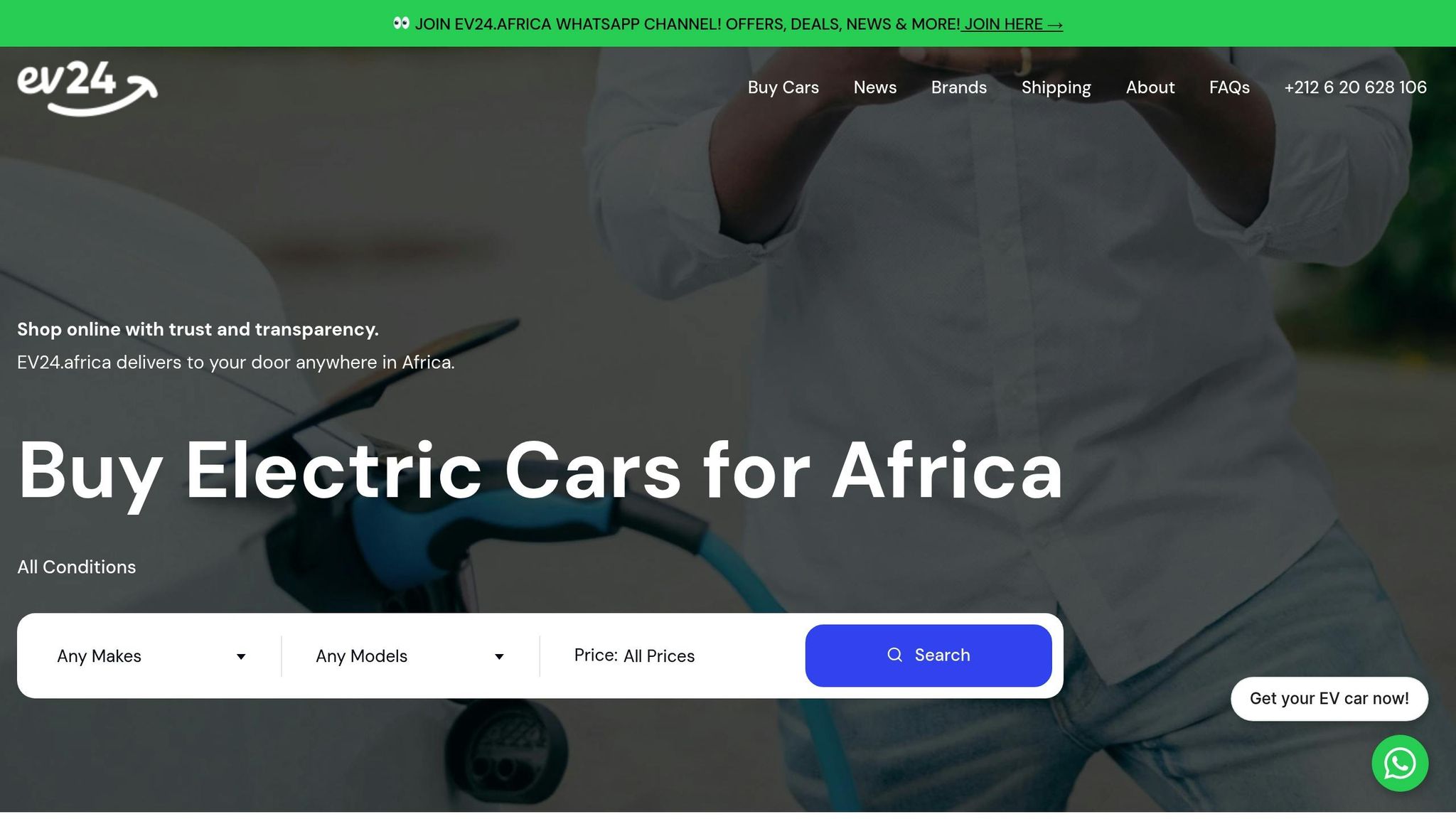
Once your maintenance plans are sorted, consider using EV24.africa for ongoing support and future purchases. This platform is a one-stop shop for EV enthusiasts, offering new and pre-owned EVs, flexible financing options, and connections to expert maintenance providers.
EV24.africa delivers vehicles across all 54 African countries, making it especially useful for businesses managing fleets in multiple locations – whether in Cape Town, Johannesburg, or beyond. The platform also features customer reviews, helping you find trusted service providers and connect with other EV owners. These reviews can be a goldmine for advice on maintenance, modifications, or troubleshooting.
For sellers, EV24.africa offers listing options ranging from free basic plans to premium dealer packages that boost visibility. Whether you’re buying, selling, or just looking for reliable support, this platform has you covered.
Conclusion
Bringing your electric vehicle (EV) to South Africa in 2025 can be achieved in just seven straightforward steps, covering everything from picking the right model to completing the registration process.
It’s crucial to meet local requirements, such as using right-hand drive models and obtaining SABS certification. Skipping these steps could lead to denied entry, expensive modifications, or even confiscation of your vehicle.
Make sure you have a solid financial plan in place. Budget for key expenses like a 25% import duty, 15% VAT, shipping fees ranging from $1,500 to $4,500, as well as SABS certification costs, registration, and related levies.
To simplify the process, consider working with experienced partners like EV24.africa. They can handle everything from finding compliant vehicles to managing the paperwork and shipping logistics.
With Africa’s EV market projected to surpass 30,000 units by 2025, this is an exciting time for both individual buyers and businesses to get involved.
FAQs
What challenges might you face when importing an EV to South Africa?
Importing an EV to South Africa isn’t exactly a smooth ride. One of the biggest obstacles? High import duties and taxes. These can drive up the total cost by as much as 55%! That includes a hefty 25% import duty, plus additional taxes that can add up to another 30%. All of this makes EVs a much pricier option in South Africa compared to other parts of the world.
Then there’s the issue of limited EV infrastructure. South Africa has fewer charging stations and repair facilities, which can make owning and maintaining an EV a bit of a headache. On top of that, the country’s energy supply challenges and complicated regulatory processes add more layers of difficulty to bringing an EV across the border.
All these factors combined make importing EVs into South Africa a tougher and costlier endeavor compared to countries with lower tariffs and better EV support systems.
How can I find a trustworthy service provider to maintain my imported EV in South Africa?
When it comes to keeping your imported EV in top shape, it’s important to find service providers who truly understand electric vehicles. Look for mechanics or companies that have specialized training and certifications in EV maintenance. These experts are better prepared to address the unique needs of electric cars.
Another great resource is the EV owner community. Online forums and groups are filled with experienced users who often share recommendations for trusted service providers. Just make sure to confirm that the provider has experience working with your specific EV model to ensure dependable and high-quality care.
What are some ways to lower import duties and taxes when bringing an EV into South Africa?
Reducing import duties and taxes on electric vehicles (EVs) in South Africa comes with its share of challenges, but there are ways to approach the issue. One potential strategy is pushing for policy adjustments to lower the current 25% import tariff and the up to 30% ad valorem tax on EVs. Efforts are already in motion to bring these rates closer to the 18% tariff applied to internal combustion engine vehicles, which would create a more balanced playing field.
On the production side, South Africa provides tax incentives aimed at boosting local EV manufacturing. For instance, there’s a 150% tax deduction available for qualifying investments in EV production. While this doesn’t directly cut import costs, it could pave the way for more locally-produced EVs, potentially making them more accessible in the long run. Keeping track of these policy changes and incentives is crucial for finding ways to lower costs and expand EV adoption.


